service indicator CADILLAC DEVILLE 1996 7.G Owners Manual
[x] Cancel search | Manufacturer: CADILLAC, Model Year: 1996, Model line: DEVILLE, Model: CADILLAC DEVILLE 1996 7.GPages: 354, PDF Size: 20.32 MB
Page 86 of 354
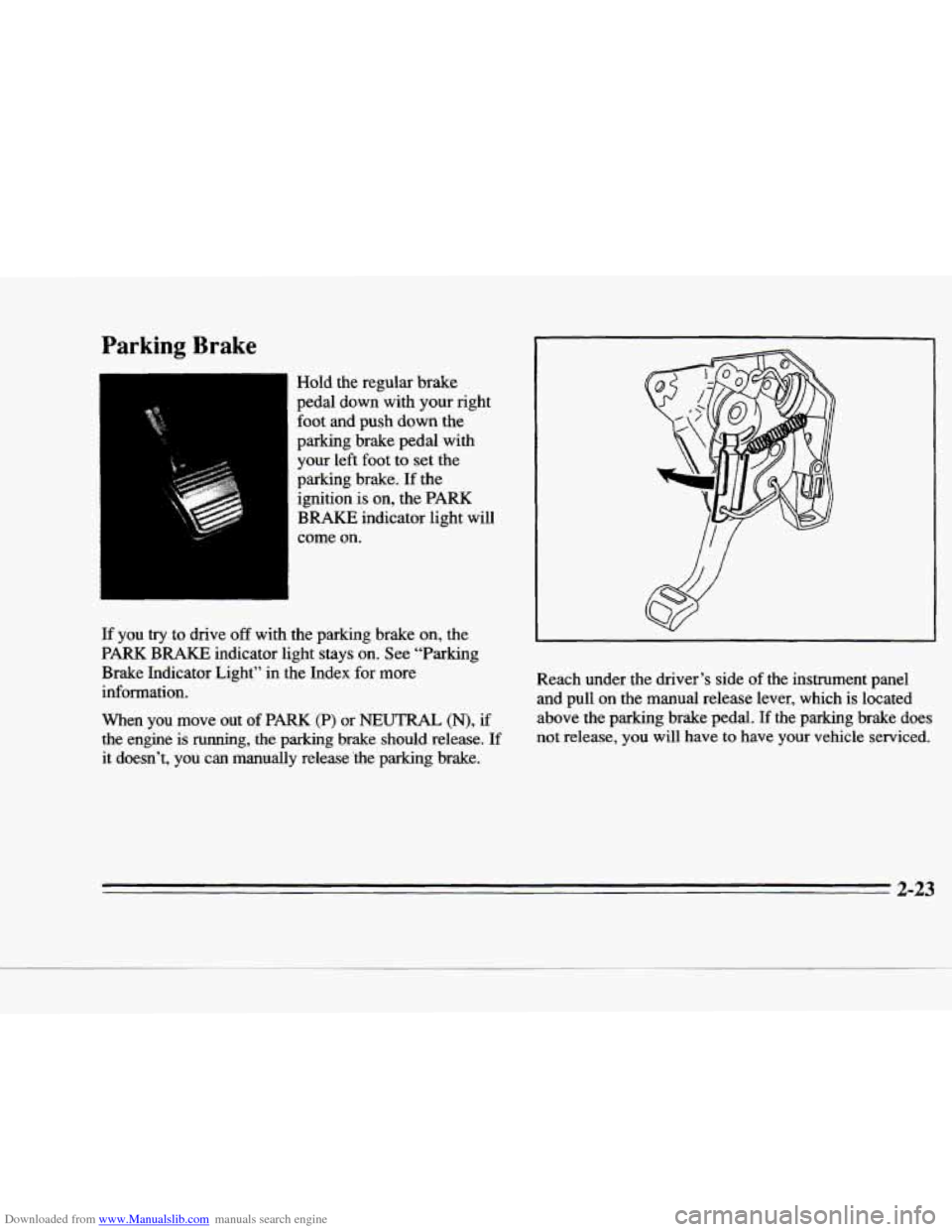
Downloaded from www.Manualslib.com manuals search engine F
c
Parking Brake
Hold the regular brake
pedal down with your right foot and push
down the
parking brake pedal with
your left foot to set the
parking brake. If the
ignition
is on, the PARK
BRAKE indicator light will
come
on.
If you try to drive off with the parking brake on, the
PARK
BRAKE indicator light stays on. See "Parking
Brake Indicator Light" in the Index for more
information.
When you move
out of PARK (P) or NEUTRAL (N), if
the engine is
running, the parking brake should release. If
it doesn't, you can manually release 'the parking brake. Reach under the driver's side
of the instrument panel
and pull on the manual release lever, which is located
above the parking brake pedal.
If the parking brake does
not release, you will have to have your vehicle serviced.
2-23
Page 128 of 354
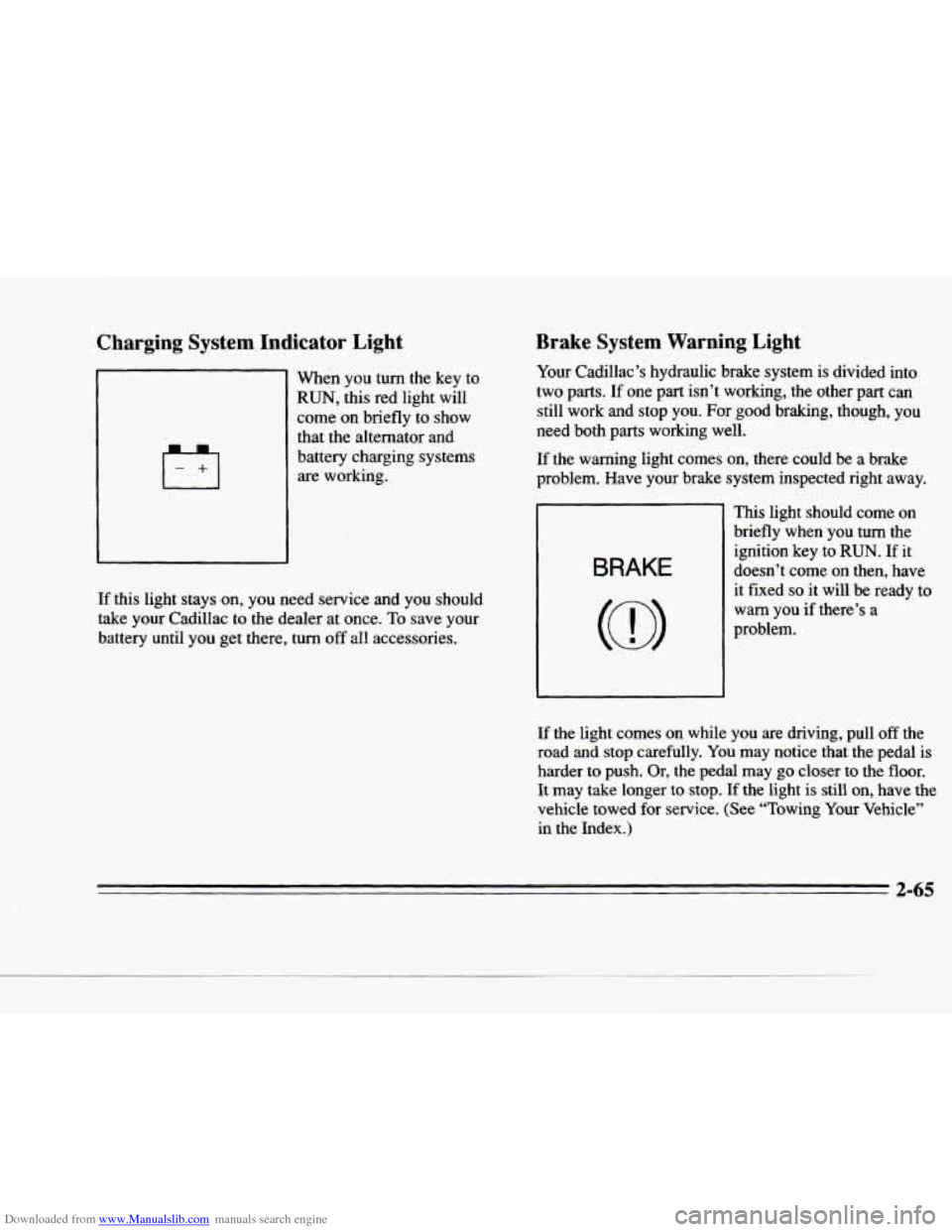
Downloaded from www.Manualslib.com manuals search engine P
P-
Charging System Indicator Light
I-el
When you turn the key to
RUN, this red light will
come
on briefly to show
that the alternator and
battery charging systems are working.
If this light stays on, you need service and you should
take your Cadillac
to the dealer at once. To save your
battery until you get there, turn off all accessories.
Brake System Warning Light
Your Cadillac’s hydraulic brake system is divided into
two parts. If one
part isn’t working, the other part can
still work and stop you. For good braking, though, you
need both parts working well.
If the warning light comes on, there could be a brake
problem. Have your brake system inspected right away.
BRAKE
This light should come on
briefly when you turn the
ignition key
to RUN. If it
doesn’t come on then, have it fixed
so it will be ready to
warn you
if there’s a
problem.
If
the light comes on while you are driving, pull off the
road and stop carefully.
You may notice that the pedal is
harder to push. Or, the pedal may
go closer to the floor.
It may take longer to stop. If the light is still on, have the
vehicle towed
for service. (See “Towing Your Vehicle”
in the Index.)
2-65
Page 129 of 354
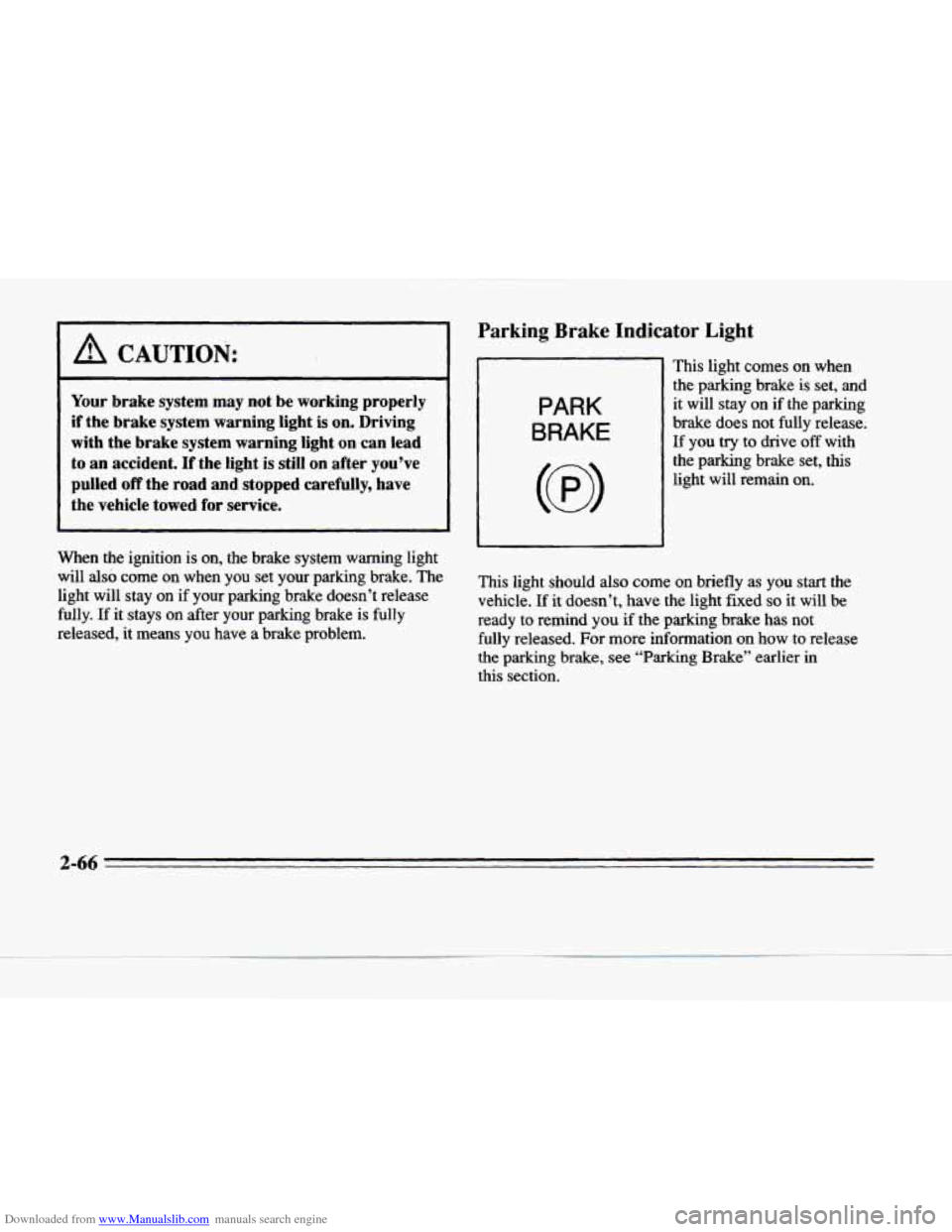
Downloaded from www.Manualslib.com manuals search engine I
I A CAUTION:
Your brake system may not be working properly if the brake system warning light is on. Driving
with the brake system warning light on can lead
to an accident.
If the light is still on after you’ve
pulled
off the road and stopped carefully, have
the vehicle towed for service.
-
When the ignition is on, the brake system warning light
will
also come on when you set your parking brake. The
light will stay on if your parking brake doesn’t release
fully. If it stays
on after your parking brake is fully
released, it means you have a brake problem.
Parking Brake Indicator Light
PARK
BRAKE
This light comes on when
the parking
brake is set, and
it will stay on if the parking
brake
does not fully release.
If you try to drive off with
the parking brake
set, this
light will remain on.
This light
should also come on briefly as you start the
vehicle. If
it doesn’t, have the light fixed so it will be
ready to remind
you if the parking brake has not
fully released. For more information
on how to release
the parking
brake, see “Parking Brake” earlier in
this section.
-.
2-66
Page 132 of 354
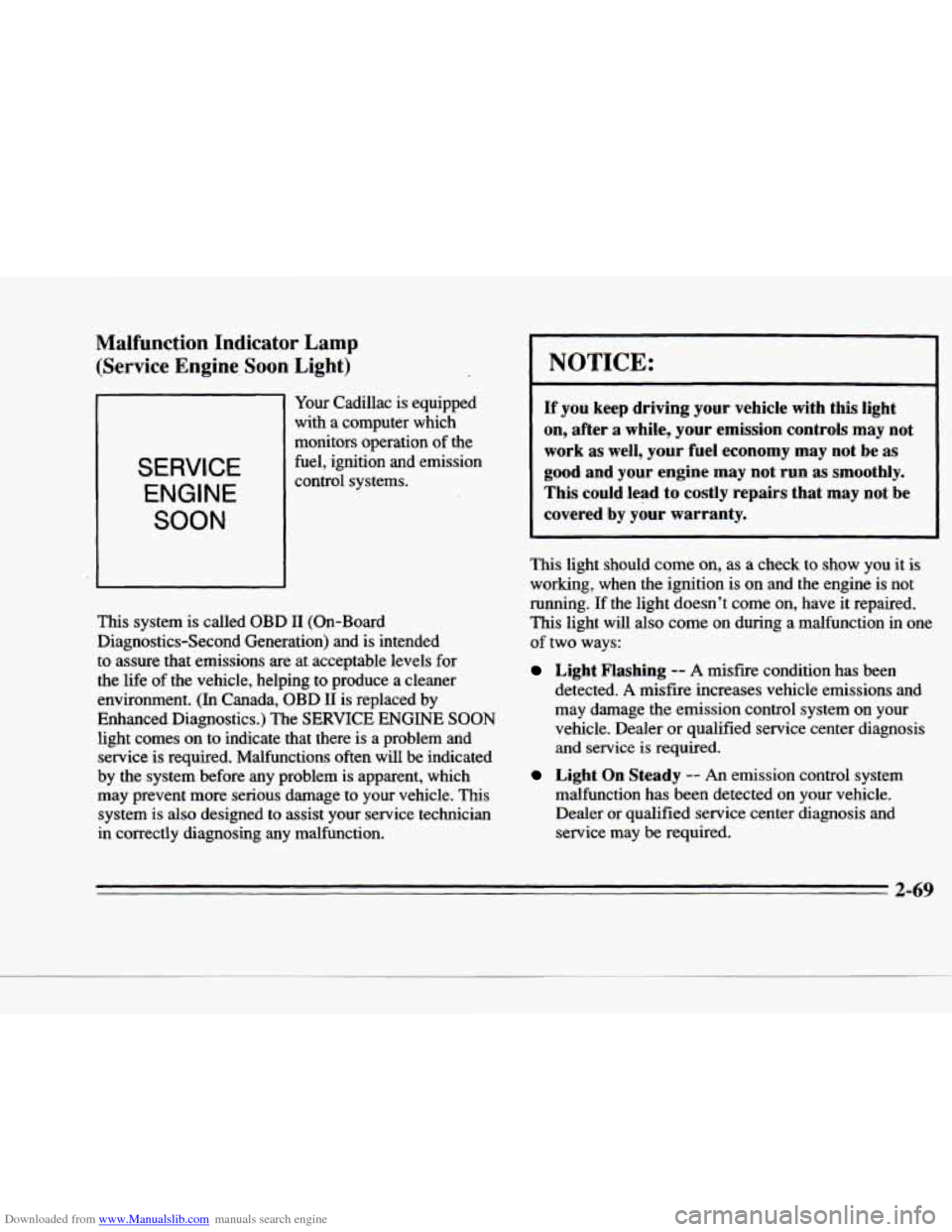
Downloaded from www.Manualslib.com manuals search engine c
c
c
Malfunction Indicator Lamp
(Service Engine Soon Light)
SERVICE
ENGINE
SOON
Your Cadillac is equipped
with a computer which
monitors operation
of the
fuel, ignition and emission
control systems.
This system is called OBD
I1 (On-Board
Diagnostics-Second Generation) and is intended
to assure that emissions are at acceptable levels for
the life
of the vehicle, helping to produce a cleaner
environment. (In Canada, OBD I1 is replaced by
Enhanced Diagnostics.) The SERVICE
ENGINE SOON
light comes on to indicate that there is a problem and
service is required. Malfunctions often will
be indicated
by the system before any problem is apparent, which
may prevent more serious damage to your vehicle. This
system is also designed to assist your service technician
in correctly diagnosing any malfunction.
NOTICE:
-
If you keep driving your vehicle with this light
on, after
a while, your emission controls may not
work
as well, your fuel economy may not be as
good and your engine may not run as smoothly.
This could lead to costly repairs that may not be
covered
by your warranty.
This light should come on, as a check to show you it is
working, when
the ignition is on and the engine is not
running.
If the light doesn’t come on, have it repaired.
This light will also come on during a malfunction in one
of two ways:
Light FIashing -- A misfire condition has been
detected.
A misfire increases vehicle emissions and
may damage the emission control system on your
vehicle. Dealer or qualified service center diagnosis
and service
is required.
Light On Steady -- An emission control system
malfunction has been detected on your vehicle. Dealer or qualified service center diagnosis and
service may be required.
2-69
Page 140 of 354
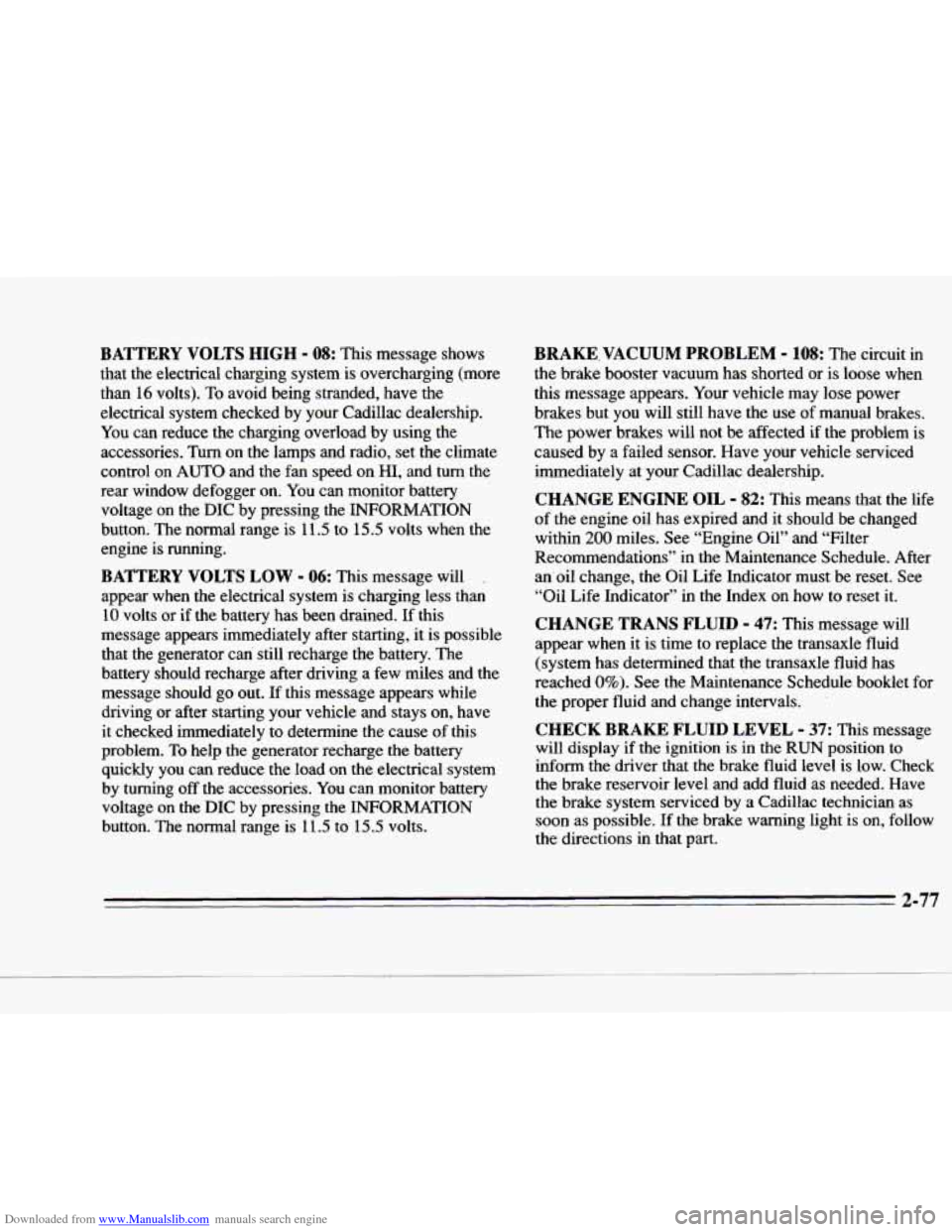
Downloaded from www.Manualslib.com manuals search engine c
I-
BATTERY VOLTS HIGH - 08: This message shows
that the electrical charging system is overcharging (more
than
16 volts). To avoid being stranded, have the
electrical system checked by your Cadillac dealership.
You can reduce the charging overload by using the
accessories.
Turn on the lamps and radio, set the climate
control on
AUTO and the fan speed on HI, and turn the
rear window defogger on. You can monitor battery
voltage on the DIC by pressing the INFORMATION
button. The normal range is
11.5 to 15.5 volts when the
engine
is running.
BATTERY VOLTS LOW - 06: This message will .
appear when the electrical system is charging less than
10 volts or if the battery has been drained. If this
message appears immediately after starting, it is possible that the generator can stili recharge
the battery. The
battery should recharge after driving a few miles and the
message should go out.
If this message appears while
driving or after starting your vehicle and stays on, have
it checked immediately to determine the cause of this
problem.
To help the generator recharge the battery
quickly
you can reduce the load on the electrical system
by turning off the accessories. You can monitor battery voltage on the
DIC by pressing the INFORMATION
button. The normal range is
11.5 to 15.5 volts.
BRAKE.VACUUM PROBLEM - 108: The circurr in
the brake booster vacuum has shorted or is loose when
this message appears. Your vehicle may lose power
brakes but you will still have the use
of manual brakes.
The power brakes will not be affected if the problem is
caused by a failed sensor. Have your vehicle serviced
immediately at your Cadillac dealership.
CHANGE ENGINE OIL - 82: This means that the life
of the engine oil has expired and it should be changed
within
200 miles. See “Engine Oil” and “Filter
Recommendations” in the Maintenance Schedule. After
an’oil change, the Oil Life Indicator must be reset. See
“Oil Life Indicator’’ in the Index on how to reset
it.
CHANGE TRANS FLUID - 47: This message WUI
appear when it is time to replace the transaxle fluid
(system has determined that the transaxle fluid has
reached
0%). See the Maintenance Schedule booklet for
the proper fluid and change intervals.
’
CHECK BRAKE FLUID LEVEL - 37: This message
will display if the ignition is in the RUN position to
inform the driver that the brake fluid level is low. Check
the brake reservoir level and add fluid as needed. Have the brake system serviced by a Cadillac technician as soon as possible. If the brake warning light is
on, follow
the directions in that part.
3-77
Page 263 of 354
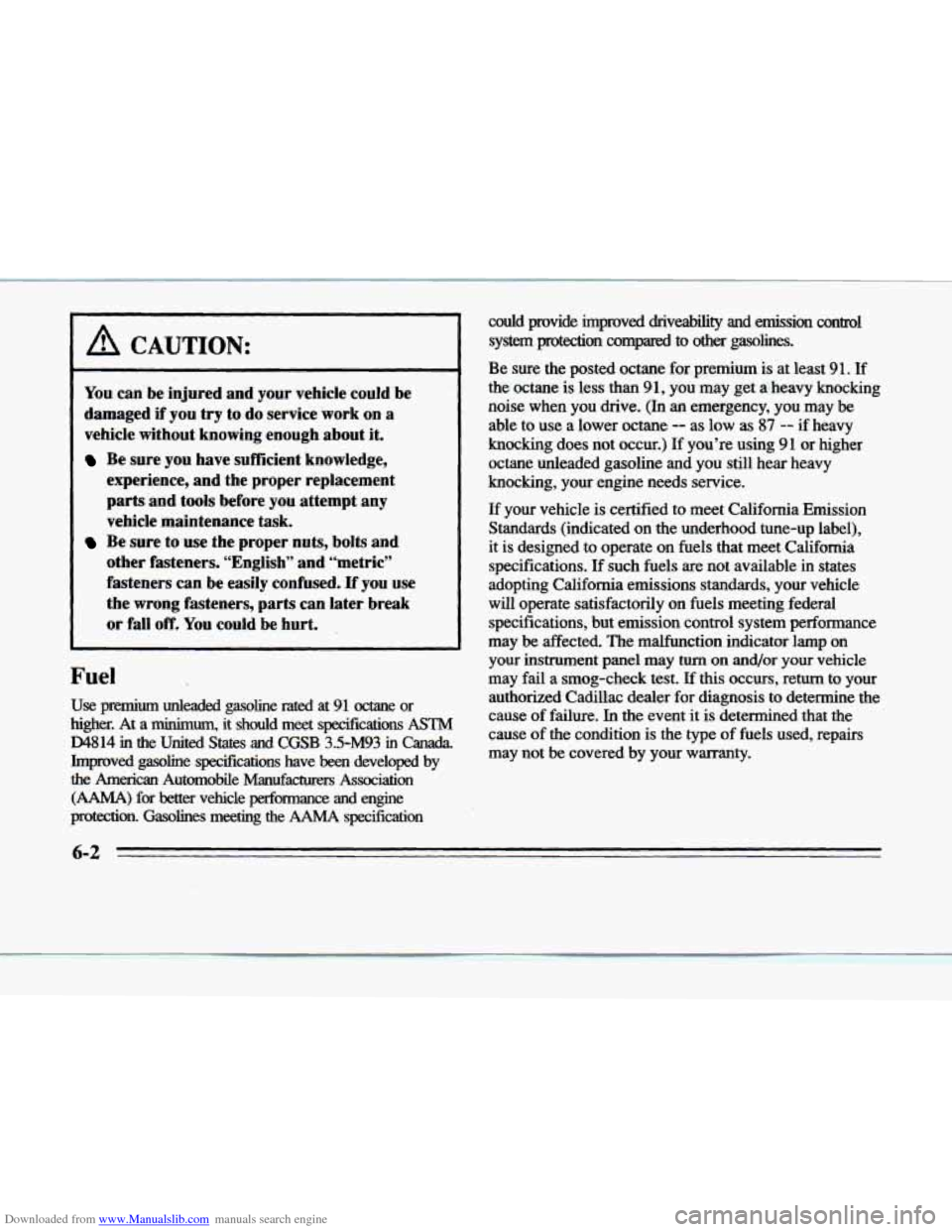
Downloaded from www.Manualslib.com manuals search engine c-
I A CAUTION:
You can be injured and your vehicle could be
damaged if
you try to do service work on a
vehicle without knowing enough about it.
Be sure you have sufficient knowledge,
experience, and the proper replacement
parts and tools before you attempt any vehicle maintenance task.
Be sure to use the proper nuts, bolts and
other fasteners. “English’ and “metric”
fasteners can be easily confused. If you use
the wrong fasteners, parts can later break
or fall off. You could be hurt.
Fuel
Use premiurn unleaded gasoline rated at 91 octane or
higher.
At a minimum, it should meet specifications ASTM
D4814 in the United States and CGSB 3.5-M93 in Canada.
Improved gasoline specifications have been developed by
the American Automobile Manufacturers Association
(AAMA) for better vehicle performance and engine
protection. Gasolines meeting the
AAMA specification could provide improved driveability and emission control
system protection compared to other gasolines.
Be sure the posted octane for premium is at least
91. If
the octane is less than
91, you may get a heavy knocking
noise when you drive.
(In an emergency, you may be
able to use a lower octane
-- as low as 87 -- if heavy
knocking does not occur.) If you’re using
91 or higher
octane unleaded gasoline and you still hear heavy
knocking, your engine needs service.
If your vehicle is certified to meet California Emission
Standards (indicated on the underhood tune-up label),
it is designed to operate on fuels that meet California
specifications. If such fuels are not available
in states
adopting California emissions standards, your vehicle
will operate satisfactorily on fuels meeting federal
specifications, but emission control system performance
may be affected. The malfunction indicator lamp on
your instrument panel may
turn on and/or your vehicle
may fail a smog-check test. If this occurs, return to your
authorized Cadillac dealer for diagnosis to determine the
cause
of failure. In the event it is determined that the
cause of the condition is the type of fuels used, repairs
may not be covered by your warranty.
6-2
Page 264 of 354

Downloaded from www.Manualslib.com manuals search engine P
P
P
c
In Canada, some gasolines contain an octane-enhancing
additive called
“T. If you use such fuels, your
emission control system performance may deteriorate
and
the malfunction indicator lamp on your instrument
panel may turn on. If this happens, return
to your
authorized Cadillac dealer for service.
To provide cleaner air, all gasolines are now required to
contain additives that will help prevent deposits from
forming
in your engine and fuel system, allowing your
emission control system
to function properly. Therefore,
you should not have to add anything to the fuel. In
addition, gasolines containing oxygenates, such as ethers
and ethanol, and reformulated gasolines may be
available
in your area to help clean the air. General
Motors recommends that you use these gasolines if they
comply with
the specifications described earlier.
NOTICE:
Your vehicle was not designed for fuel that
contains methanol. Don’t use it. It can corrode
metal parts
in your fuel system and also damage
plastic and rubber parts. That damage wouldn’t
be covered under your warranty.
Fuels in Foreign Countrics
If you plan on driving in another country outside the
United States or Canada, the proper fuel may be hard to
find. Never use leaded gasoline or any other fuel not
recommended in
the previous text on fuel. Costly repairs
caused by
use of improper fuel wouldn’t be covered by
your warranty.
To check on fuel availability, ask an auto club, or
contact a major oil company that does business in the
country where you’ll be driving.
You can also write us at the following address for
advice. Just tell us where you’re going and give your
Vehicle Identification Number (VIN).
General Motors Overseas Distribution Corporation North American Export Sales
(NAES)
1908 Colonel Sam Drive
Oshawa, Ontario
L1H 8P7
6-3
Page 274 of 354
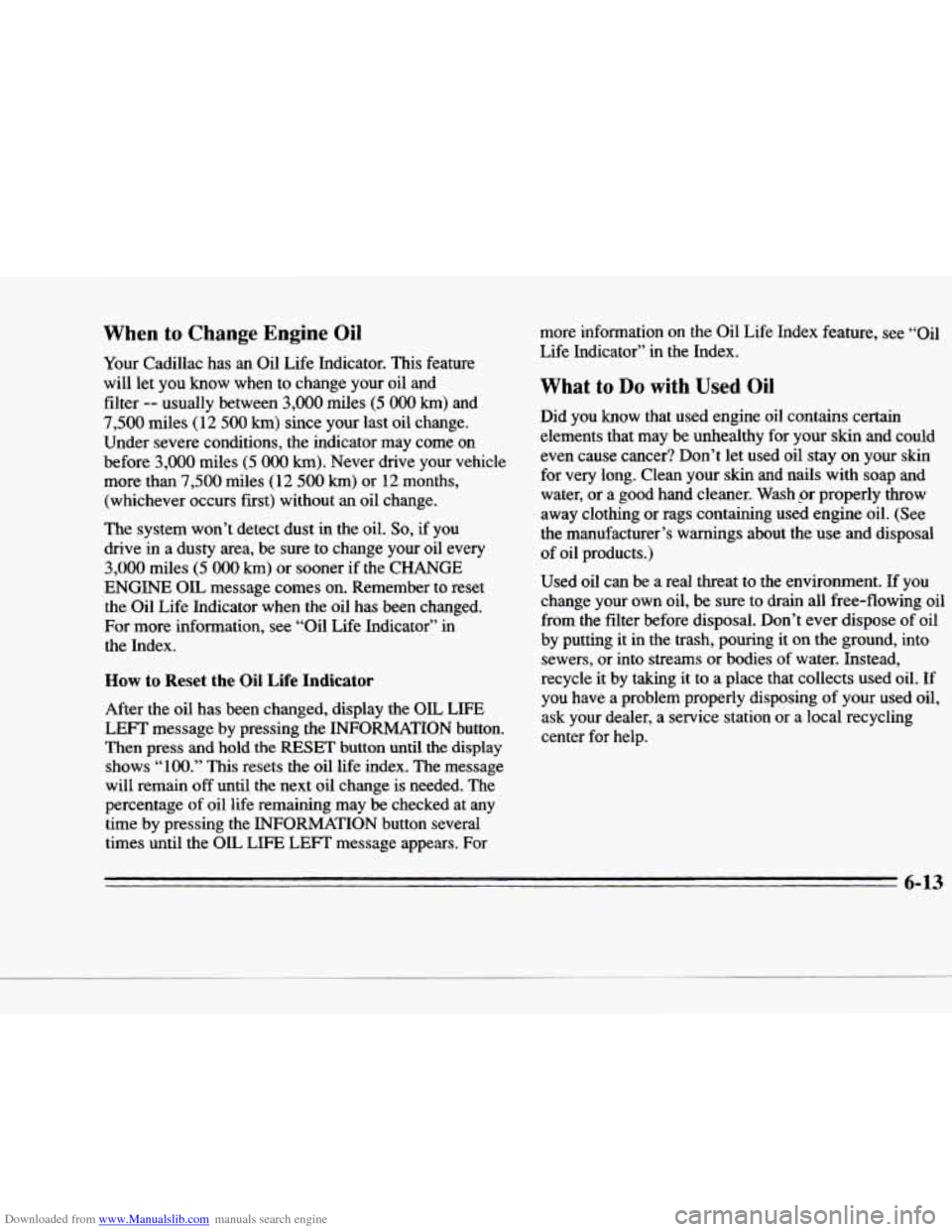
Downloaded from www.Manualslib.com manuals search engine CI
c-
c
When to Change Engine Oil
Your Cadillac has an Oil Life Indicator. This feature
will let you know when to change your oil and
filter
-- usually between 3,000 miles (5 000 km) and
7,500 miles (12 500 km) since your last oil change.
Under severe conditions, the indicator may come on
before
3,000 miles (5 OOO km). Never drive your vehicle
more than
7,500 miles (12 500 km) or 12 months,
(whichever occurs first) without an oil change.
The system won’t detect dust in the oil.
So, if you
drive in a dusty area, be sure to change your oil every
3,000 miles (5 000 km) or sooner if the CHANGE
ENGINE OIL message comes on. Remember to reset
the
Oil Life Indicator when the oil has been changed.
For more information, see “Oil Life Indicator”
in
the Index.
How to Reset the Oil Life Indicator
After the oil has been changed, display the OIL LIFE
LEFT message by pressing the INFORMATION button.
Then press and hold the RESET button until the display
shows
“100.” This resets the oil life index. The message
will remain off until the next oil change is needed. The
percentage of oil life remaining may be checked at any
time by pressing the INFORMATION button several
times until the
OIL LIFE LEFT message appears. For more information
on the Oil Life Index
feature, see “oil
Life Indicator” in the Index.
What to Do with Used Oil
Did you know that used engine oil contains certain
elements that may be unhealthy for your skin and could
even cause cancer? Don’t let used oil stay
on your skin
for very long. Clean your skin and nails with soap and
water, or a good hand cleaner. Wash
;or properly throw
away clothing
or rags containing used engine oil. (See
the manufacturer’s warnings about the use
and disposal
of oil products.)
Used oil can be a real threat to the environment. If you
change your own oil, be sure to drain
all free-flowing oil
from the filter before disposal. Don’t ever dispose of oil
by putting it in the trash, pouring it on the ground, into
sewers, or into streams or bodies of water. Instead,
recycle
it by taking it to a place that collects used oil. If
you have a problem properly disposing
of your used oil,
ask your dealer, a service station or a local recycling
center for help.
6-13
Page 288 of 354
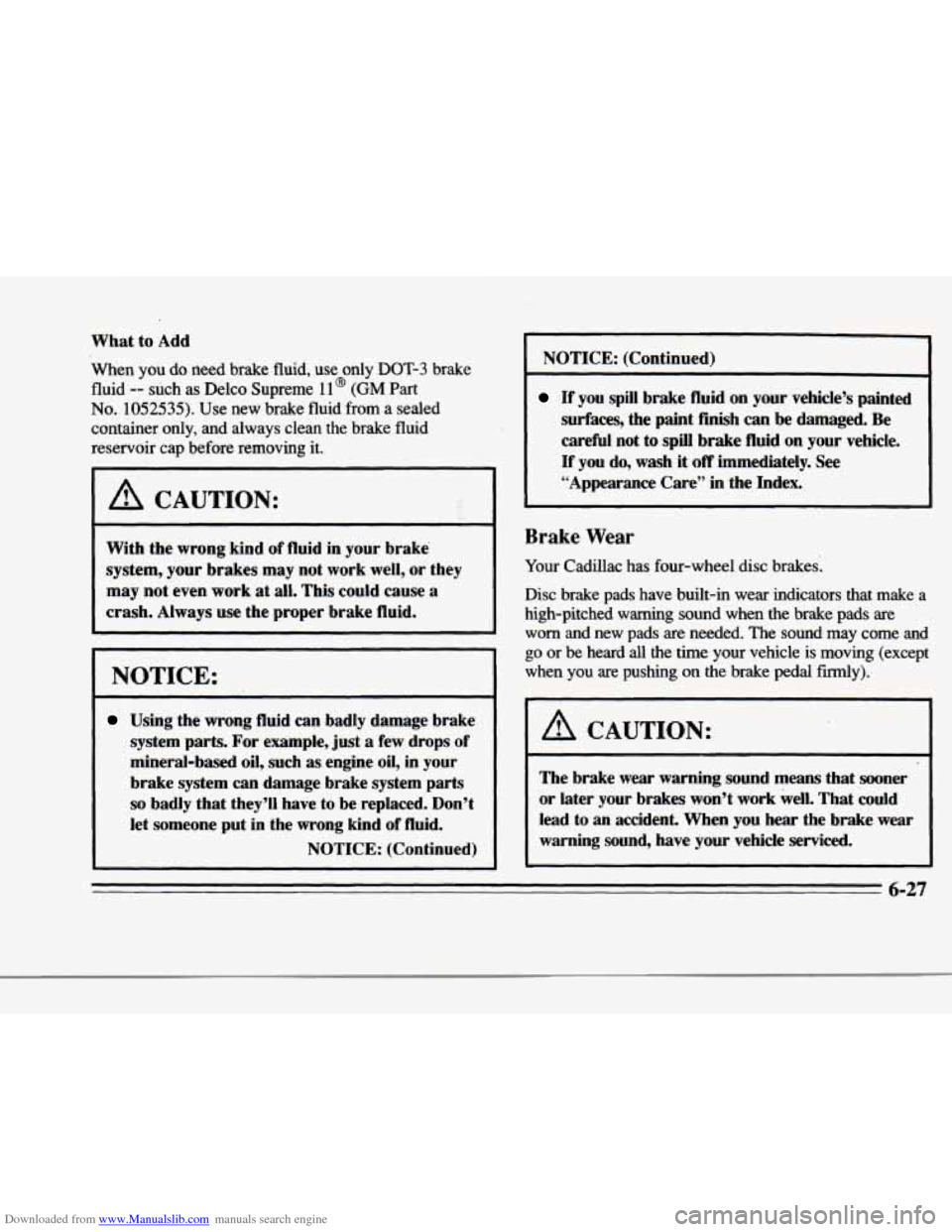
Downloaded from www.Manualslib.com manuals search engine r
Q
r
p“
f I
r
What to ,Add
When
you do need brake fluid, use only DOT-3 brake
fluid
-- such as Delco Supreme 11@ (GM Part
No. 1052535). Use new brake fluid from a sealed
container only,
and always clean the brake fluid
reservoir cap before removing
it.
A CAUTION:
With the wrong kind of fluid in your brake
system, your brakes
may not work well, or they
may not even work
at all. This could cause a
crash. Always use the proper brake fluid.
Using the wrong fluid can badly damage brake
system parts. For example, just
a few drops of
mineral-based oil, such as engine oil, in your
brake system can damage brake system
parts
so badly that they’ll have to be replaced. Don’t
let someone put in the wrong kind
of fluid.
NOTICE: (Continued) NOTICE:
(Continued)
If you spill brake fluid on your vehicle’s painted
surfaces, the paint finish can
be damaged. Be
carefbl not to spill brake
fluid on your vehicle.
If you do, wash it off immediately. See
“Appearance Care” in the Index.
Brake Wear
Your Cadillac has four-wheel disc brakes.
Disc brake pads have built-in wear indicators that make
a
high-pitched warning sound when the brake pads are
worn
and new pads are needed. The sound may come and
go or be heard all the time your vehicle is moving (except
when you are pushing on the brake
pedal fmly).
A CAUTION:
The brake wear warning sound means that sooner
or later your brakes won’t work well. That could
lead to
an accident. When you hear the brake wear
warning sound, have your vehicle serviced.
6-27
r
I
Page 300 of 354
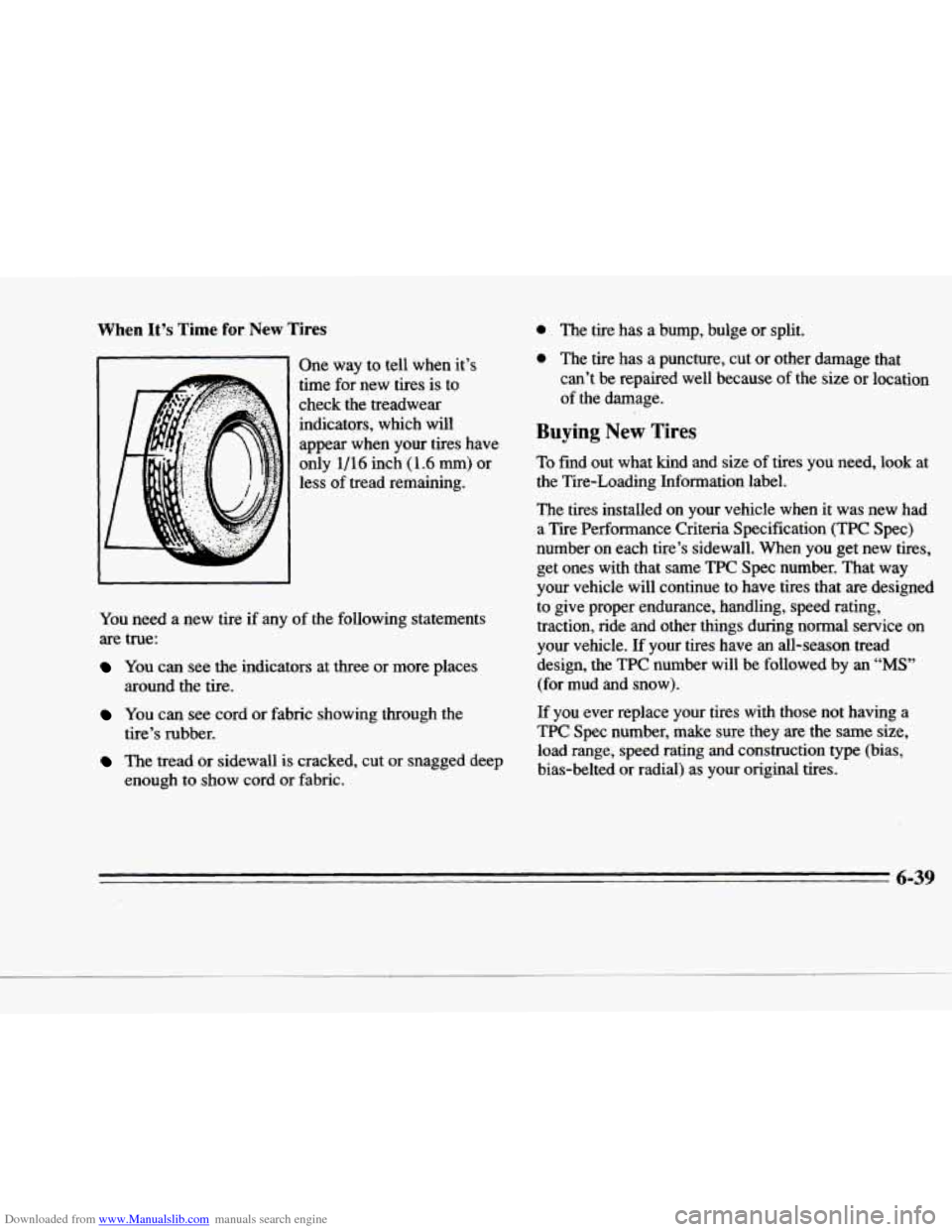
Downloaded from www.Manualslib.com manuals search engine c
When It’s Time for New Tires
One way to tell when it’s
1 A time for-new tires is to
check the treadwear indicators,
which will
appear when
your tires have
only 1/16 inch (1.6 mm) or
less
of tread remaining.
+- You need a new tire if any of the following statements
are true:
c
You can see the indicators at three or more places
around the tire.
You can see cord or fabric showing through the
The tread or sidewall is cracked, cut or snagged deep
tire’s rubber.
enough
to show cord or fabric.
0 The tire has a bump, bulge
or split.
0 The tire has a puncture, cut or other damage that
can’t be repaired
well because of the size or location
of the damage.
Buying New Tires
To find out what kind and size of tires you need, look at
the Tire-Loading Information label.
The tires installed on your vehicle when it was new had a Tire Performance Criteria Specification
(TPC Spec)
number on each tire’s sidewall. When you get new tires, get ones with that same
TPC Spec number. That way
your vehicle will continue to have tires that are designed
to give proper endurance, handling, speed rating,
traction, ride and other things during normal service on your vehicle.
If your tires have an all-season tread
design, the TPC number will be followed
by an “MS”
(for mud and snow).
If you ever replace your tires with those not having a
TPC Spec number, make sure they are the same size,
load range, speed rating and construction type (bias,
bias-belted or radial) as your original tires.
6-39